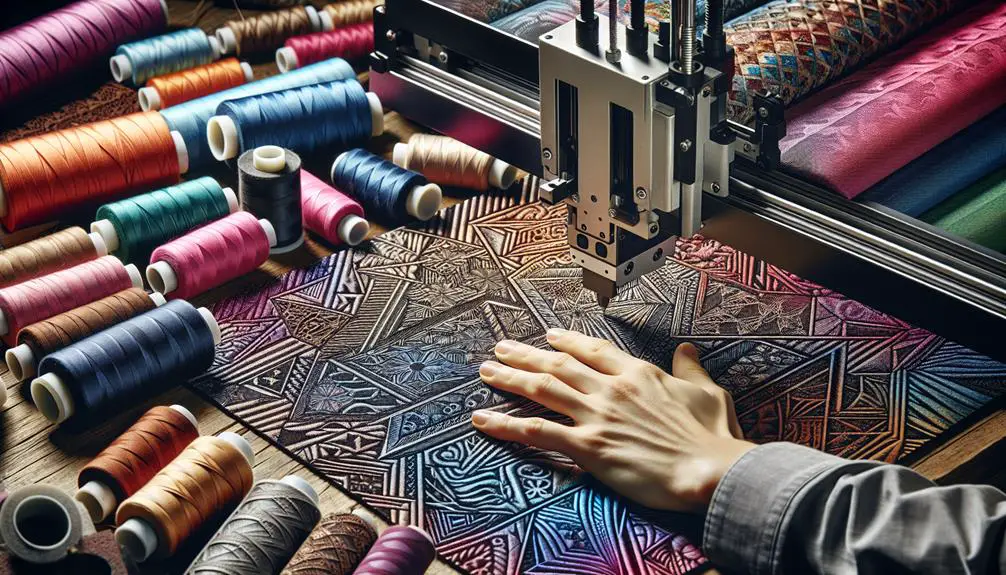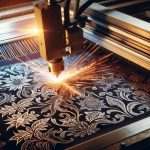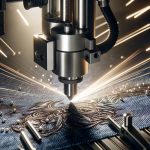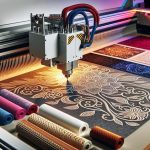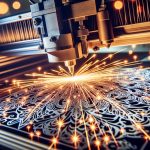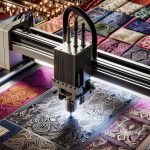Laser engraving can transform your fabric designs with precise customization and intricate details. Start by selecting appropriate fabrics like cotton or linen, which handle engraving well. Use design software like Adobe Illustrator for creating vector files that guarantee sharp results. Adjust the laser's power and speed settings to match the fabric type. Test on small samples first. Explore adding textures and depth for a distinctive touch. Post-engraving, gently clean the fabric to maintain the design. This technique not only enhances visual appeal but also adds a deluxe feel to your projects. There's plenty more to explore about mastering this technique!
Table of Contents
Key Takeaways
- Optimize Image Resolution: Use high-contrast black and white images with 300 DPI or higher for sharp and precise engravings.
- Select Appropriate Fabrics: Choose natural fabrics like cotton for clean engravings and darker fabrics for better contrast.
- Fine-Tune Laser Settings: Adjust power, speed, and depth settings based on fabric properties to avoid damage and achieve desired results.
- Incorporate Textures: Experiment with laser power and speed to create unique textures and dimensions on fabric.
- Test Before Engraving: Conduct test engravings on small fabric samples to refine settings and ensure optimal outcomes.
Understanding Laser Engraving
Before diving into the techniques, it's important to understand what laser engraving actually entails. Laser engraving uses a focused beam of light to precisely remove material from the surface of a fabric, creating intricate designs with high accuracy.
The benefits of laser engraving are numerous: it allows for detailed customization, is faster than traditional methods, and can handle complex patterns with ease. Knowing these advantages can help you leverage the technology effectively in your projects.
However, it's equally essential to grasp the limitations of laser engraving. Not all fabrics are suitable for this process, and some materials may react poorly to the heat, causing discoloration or damage. Understanding these limitations can save you time and resources, ensuring better results in your designs.
Incorporating laser technology into your fabric design trends can set you apart in a competitive market. Today's trends emphasize unique textures and patterns, which laser engraving can deliver flawlessly. By integrating this technology, you'll be able to create innovative designs that meet modern demands.
Mastering laser engraving will give you a significant edge, enabling you to push the boundaries of fabric design.
Selecting the Right Fabric
Choosing the right fabric is important for achieving the best results with laser engraving. When you're selecting your fabric, consider both the material and color to make sure your design stands out. Different fabrics react uniquely to laser engraving, and your choice can make or break the final product.
Start with fabric selection. Natural fabrics like cotton or linen are excellent because they engrave cleanly. Synthetic fabrics, such as polyester, can also be engraved but may require more precise settings. Each fabric type will react differently under the laser, so it's essential to test before starting your main project.
Color considerations play a role in how visible your engraving will be. Darker fabrics often provide better contrast, making your design pop. Lighter fabrics can be used, but the engraving might not be as pronounced unless you adjust the settings accordingly.
Here's a quick reference table to guide you:
| Fabric Type | Engraving Quality | Color Considerations |
|---|---|---|
| Cotton | High | Best with dark colors |
| Linen | High | Dark colors recommended |
| Polyester | Variable | Suitable for all colors |
Preparing Your Design
To get started with preparing your design, you'll need to choose the appropriate design software that suits your needs.
Make sure your image resolution is optimized for the best engraving results.
Choosing Design Software
Selecting the right design software is vital for ensuring that your laser engraving projects on fabric turn out perfectly. Start by choosing a program that allows you to easily incorporate design inspiration and create unique graphic elements. Software like Adobe Illustrator or CorelDRAW are popular choices because they provide robust tools for drawing and editing. These programs also support vector files, which are essential for precision in laser engraving.
Next, think about your color palette and layout composition. Even though laser engraving primarily deals with textures and depths rather than colors, having a clear vision of your design's color scheme can help you plan the layout more effectively. Use your software to experiment with different layouts and compositions until you find one that balances well and highlights your main elements.
User-friendly features like layers, grids, and guides in your design software will help you manage complex designs more efficiently. Don't forget to use the software's preview functions to visualize how your design will look when engraved on fabric. This practice helps you catch any potential issues early on, ensuring a smoother engraving process.
Optimizing Image Resolution
Ensuring your image resolution is vital to achieving sharp and detailed laser engravings on fabric. Start by selecting a high-quality image, ideally 300 DPI (dots per inch) or higher. This resolution guarantees that your design's fine details are accurately captured, which is essential when dealing with intricate designs.
Consider your color options thoughtfully. While laser engraving doesn't incorporate colors, the contrast in your image can impact its appearance on various fabric types. High-contrast black and white images are most effective.
Next, consider the design complexity. Simple designs with strong lines and minimal details generally transfer better to fabric. Intricate designs can be challenging, as the finer points may be lost depending on the fabric type and its engraving limitations.
For instance, detailed patterns may not show up well on dense fabrics like denim but could be striking on lightweight fabrics like cotton.
Various fabric types also impact the quality of your engraving. Natural fibers like cotton and linen typically engrave more effectively than synthetic materials. Understanding your fabric's engraving constraints can assist you in adjusting your design for optimal outcomes.
Setting Up Templates
When setting up templates for your laser engraving project, it's important to start by accurately aligning your design within your software's workspace. This guarantees that what you see on your screen matches the final output on your fabric. Begin by importing your design and use the grid and alignment tools to center it properly. This step is vital for template customization and achieving the best design alignment.
Next, consider the material you're working with. Different fabrics have unique properties, so check for material compatibility. Some fabrics, like cotton, respond better to laser engraving than others, such as polyester. Knowing your material helps you adjust settings for cutting precision.
After aligning your design and confirming material compatibility, customize the template to fit your specific project needs. Use the software's features to adjust the size, shape, and layout of your design. This level of template customization guarantees that your final product looks professional and exactly how you envisioned it.
Setting Up the Laser
Before you start engraving, make certain your laser machine is properly set up and calibrated. Begin by checking the laser alignment. This step guarantees that the laser beam hits the exact spot you intend on your fabric. Use the alignment tools provided with your machine and follow the manufacturer's instructions to adjust the mirrors and lenses.
Next, focus on the power settings. Different fabrics require different power levels to achieve the desired engraving depth and clarity. For delicate fabrics, use lower power settings to avoid burning or damaging the material. Conversely, thicker fabrics might need higher power settings. Test on a small fabric piece first to find the best settings.
Don't forget to adjust the speed settings, as the engraving speed also impacts the final result. Slower speeds allow for deeper engravings, while faster speeds are suitable for lighter marks.
Lastly, make sure your work area is clean and free of obstructions. A tidy space helps maintain the quality of your engravings and prevents any accidents. By carefully setting up your laser, you'll pave the way for successful and precise fabric designs.
Engraving Techniques
Now that your laser is set up, let's explore some engraving techniques.
You'll learn about precision cutting methods, how to control the depth of your engravings, and tips for transferring your designs accurately to fabric.
Each of these points will help you create stunning, detailed fabric designs.
Precision Cutting Methods
Precision cutting methods in laser engraving allow fabric designers to create intricate and detailed patterns with ease. With laser precision, you can achieve cutting finesse that traditional methods can't match. Imagine being able to customize fabrics exactly to your specifications.
Whether you're working on a bespoke garment or a unique home décor piece, these techniques let you add an artistic flair that stands out.
Using a laser cutter, you can slice through various fabrics with minimal effort. The machine does most of the work, so you can focus on the creative aspects of your designs. Plus, with the high level of accuracy, you won't have to worry about frayed edges or uneven cuts. This is especially useful if you're working with delicate materials like silk or lace.
Another advantage is speed. Laser cutting can save you a significant amount of time compared to hand-cutting. You can quickly produce multiple pieces with the exact same dimensions, ensuring consistency across your projects. This method not only enhances the quality of your work but also boosts your productivity.
Depth Control Settings
When you're laser engraving fabrics, mastering depth control settings is vital for achieving the perfect finish.
First, you need to get familiar with depth measurement. This guarantees the laser engraves at the right depth, preventing it from cutting too shallow or too deep.
Depth measurement directly impacts cutting quality. If the depth is too shallow, the design may not stand out, while too deep can damage the fabric.
To fine-tune the depth, start with test engravings on scrap pieces. Adjust the settings incrementally until you achieve the desired result.
Material compatibility is another key factor. Different fabrics react differently to laser engraving. Natural fibers like cotton and linen generally require different settings than synthetic fibers like polyester.
Always consult the fabric's specifications and adjust accordingly.
Engraving speed also plays a pivotal role. A slower engraving speed allows the laser to cut deeper, while a faster speed results in a more superficial cut.
Balance the speed with depth settings to get the best engraving on your fabric.
Design Transfer Tips
To guarantee your fabric designs transfer flawlessly during laser engraving, here are some essential tips to follow.
First, make sure your color scheme is optimized for laser engraving. Since lasers interpret colors in terms of different shades of gray, stick to high-contrast colors that will translate well into varying levels of engraving depth.
Next, focus on your visual elements. Detailed designs with intricate patterns can sometimes get lost in translation. Simplify your visual elements to ensure clarity. Clean lines and bold shapes tend to engrave more effectively.
Here's a handy list to help you out:
- Optimize Contrast: Use a high-contrast color scheme to make sure your design's details stand out.
- Simplify Visuals: Simplify your visual elements for better clarity and precision during engraving.
- Test Small Samples: Always test your design on a small fabric sample first to see how well your design transfers and adjust as needed.
Adding Texture
You can easily add depth and dimension to your fabric designs by incorporating various laser engraving techniques. Texture manipulation is key to making your designs stand out. By adjusting the laser's power and speed, you can create a range of textures, from subtle, raised patterns to more pronounced, etched effects. Experimenting with these settings will give you a better understanding of how different textures interact with your chosen fabrics.
Start by gathering some creative inspiration. Look at natural textures like wood grain, pebbles, or leaves. Think about how these patterns could enhance your fabric. You might also find inspiration in architectural details or abstract shapes.
Once you have some ideas, test them on small fabric swatches. This way, you can see how the textures look and feel before committing to a larger piece.
Enhancing Details
Enhancing details in your fabric designs can metamorphose a simple pattern into an intricate masterpiece. When you focus on the finer points, your work stands out and catches the eye.
For starters, pay attention to color variation and pattern alignment. By guaranteeing that your colors complement and contrast well, you create a visual pop that makes your design more appealing. Proper pattern alignment ensures that everything fits together seamlessly, giving a professional touch to your fabric.
Next, consider incorporating shadow effects. Shadows can add depth and dimensions to your design, making it look more dynamic. You can use your laser engraver to create subtle shadows that resemble natural light, giving your fabric a three-dimensional feel.
Finally, don't forget about gradient blending. Smooth shifts between colors can enhance your design's overall look. With careful use of the laser engraving tool, you can achieve beautiful gradients that make your patterns come to life.
Here's a quick rundown to help you enhance details:
- Color variation and pattern alignment: Make your design visually striking and professional.
- Shadow effects: Add depth and dimension.
- Gradient blending: Create smooth shifts for a polished look.
Master these techniques, and your fabric designs will elevate to a whole new level.
Post-Engraving Care
Once you've perfected the intricate details of your fabric design, it's crucial to focus on post-engraving care to guarantee your work remains in top condition.
Start with post-engraving cleaning. Use a soft brush or a lint roller to remove any debris or residue left on the fabric. This safeguards that the engraved areas remain crisp and clear.
Next, consider fabric preservation. To prevent discoloration, keep your fabric out of direct sunlight and away from harsh chemicals. Opt for gentle detergents if you need to wash the fabric, and always do a spot test first. Air drying is preferable to using a dryer, which can cause the fabric to fade or shrink.
Now, let's discuss storage solutions. Store your engraved fabric in a cool, dry place. Use acid-free tissue paper to wrap the fabric, which aids in preventing discoloration and maintains the integrity of your design. If you're storing multiple pieces, consider rolling them instead of folding to avoid creases.
Creative Applications
When it comes to creative applications, laser engraving opens up a world of possibilities for fabric designers. You can take your designs to the next level by using laser technology in ways you mightn't have imagined. Let's immerse into a few exciting options:
- Color Customization and Pattern Experimentation:
With laser engraving, you can precisely control the depth and intensity of your engravings. This allows you to experiment with patterns that can dramatically alter the appearance of your fabric. Imagine creating intricate designs that were previously too intricate to achieve by hand.
- Fabric Manipulation and Texture Variation:
Lasers can modify the texture of your fabric, giving you the ability to create raised or recessed designs. You can manipulate the fabric to produce unique textures, adding a tactile dimension to your projects. This is perfect for adding a high-end, customized feel to your designs.
- Fine Detail Work:
Lasers offer unparalleled precision, enabling you to include fine details in your designs. Whether you're working on delicate lace or heavy denim, laser engraving can help you achieve clean, crisp lines that stand out.
Using these techniques, you'll discover new levels of creativity and craftsmanship in your fabric designs.
Frequently Asked Questions
How Can I Troubleshoot Common Laser Engraving Errors on Fabric?
Think of troubleshooting errors like tuning a musical instrument. First, check your material selection. Then, adjust your speed settings and optimize your design. These steps guarantee your fabric engraving hits all the right notes.
What Are the Best Safety Practices for Laser Engraving in a Home Studio?
In your home studio, prioritize safety precautions by conducting a risk assessment. Always wear personal protective equipment like goggles and masks. Maintain proper ventilation and keep a fire extinguisher nearby to handle any emergencies.
How Do I Maintain and Clean a Laser Engraving Machine?
Think of your laser engraving machine as a loyal steed. Regular maintenance and cleaning techniques, like removing debris and checking components, will guarantee its longevity. Preventing damage is key to keeping it galloping smoothly for years.
Can I Use Any Type of Laser for Fabric Engraving?
You can't use any type of laser for fabric engraving. Laser compatibility depends on fabric types. For the best results, consider the engraving intricacies and design precision required. Choose a laser suited to your specific needs.
Where Can I Find Inspiration and Design Ideas for Laser Engraving on Fabric?
Explore a world of endless creative patterns and unique textures! You'll find inspiration on Pinterest, Instagram, and design blogs. Don't forget to check out fabric stores and fashion shows for the latest trends.
- Tetron Fabric for Marine Applications: Durability and Use Cases - June 18, 2025
- Tetron Fabric for Outdoor Furniture: Weather Resistance and Care - June 18, 2025
- Tetron Fabric for Wall Coverings: Style and Application Tips - June 18, 2025

